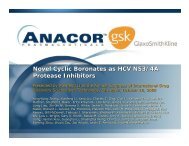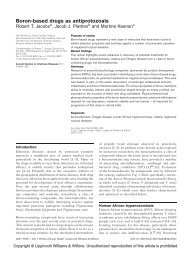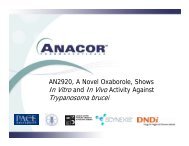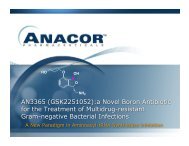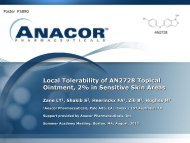Fig. 7 Reaction catalyzed by leucyl tRNA synthetase is a two-step process. First, leucine reacts with ATP to form an activated leucyl-AMP esterwith the loss <strong>of</strong> pyrophosphate, then a transesterification process relocates the leucine onto the terminal adenosine <strong>of</strong> tRNA LEU with the loss <strong>of</strong>AMP. The product, leucyl-tRNA LEU , is then used by the ribosome for protein synthesis.Fig. 9 Proposed reaction mechanism <strong>of</strong> AN2690 with tRNA LEUresulting in the spiro-product inhibitor <strong>of</strong> LeuRS.Fig. 8 X-Ray crystallography shows boron in a spiro complex withthe cis-diols <strong>of</strong> the terminal adenosine <strong>of</strong> tRNA LEU .X-Ray crystallographic studies revealed that AN2690 formsa spiro adduct, tetrahedral about boron, with the terminaladenosine <strong>of</strong> the corresponding tRNA LEU in the editing activesite 37 (Fig. 8). The boron has lost its original hydroxyl groupand formed two new bonds with the 2 0 - and 3 0 -cis diols <strong>of</strong> theribose. This complex locks the tRNA in the editing active site,preventing it from either leaving the enzyme or moving to thesynthetic active site, where it would be aminoacylated. Thisadduct also blocks other tRNA’s from binding to the enzymethus rendering it inactive. This novel mode <strong>of</strong> inhibition hasbeen termed the oxaborole tRNA trapping, or OBORT,mechanismA striking feature <strong>of</strong> AN2690 is that it is a small molecule,having a molecular weight <strong>of</strong> just 152 a.m.u. This is typicallyconsidered too small to possess any significant binding affinityand indeed, many fragment-based libraries have members withmolecular weights in excess <strong>of</strong> AN2690. Therefore, based onexperience with fragment libraries, one would anticipate thatAN2690 could sample many binding sites without expecting itto have any significant pharmacological potency. However,as can be seen with its mechanism <strong>of</strong> action, AN2690 isable to react with the terminus <strong>of</strong> tRNA LEU in the editingactive site and in doing so increases its molecular weightapproximately 170-fold (Fig. 8). This adduct occupies theentire tRNA binding site and the editing active site pocket,resulting in a very large inhibitor with a very high affinityfor LeuRS.The mechanism <strong>of</strong> action <strong>of</strong> AN2690, and its reaction withtRNA specifically, raises questions <strong>of</strong> indiscriminate reactivityand selectivity. Even though these complexes form spontaneouslyin neutral aqueous solution, they can exchange rapidlyand have very weak association constants. In the simple case<strong>of</strong> oxaborole and D-ribose, the K a is on the order <strong>of</strong> 4 M 1 atpH 6 (Tomsho and Benkovic, unpublished results). Animportant feature to note is that this AN2690–tRNA LEUcomplex was only observed in the editing active site and hasnot been observed in the synthetic active site. This fact leads usto speculate that the complex is only accumulated within theediting active site, where the small, hydrophobic pocket acts tostabilize and protect the complex from hydrolysis. Thesecomplexes hydrolyze rapidly in water and we believe that theenvironmental conditions <strong>of</strong> the LeuRS editing active site limitaccess <strong>of</strong> water to boron, thereby stabilizing the complex. Thereason these complexes are not found elsewhere, whether inthe synthetic active site <strong>of</strong> LeuRS or on some other tRNAsynthetase, might be due to their accessibility to water andsubsequent hydrolysis.The current hypothesis for the chemical reaction mechanismfollows (Fig. 9). In solution at physiological pH, AN2690exists in an acid–base equilibrium, rapidly interconvertingbetween its anionic, hydroxylated tetrahedral form and itsneutral, trigonal-planar form. When the latter form is held inclose enough proximity to the cis-diols <strong>of</strong> the tRNA, one <strong>of</strong> theribose hydroxyl groups can add to the empty p-orbital to givethe first intermediate borate ester. This step is likely to berapidly reversible. The next step could go one <strong>of</strong> the two ways:elimination–addition or substitution. In the elimination–addition pathway, the boron hydroxyl group is lost as waterThis journal is c The Royal Society <strong>of</strong> Chemistry 2011 Chem. Soc. Rev., 2011, 40, 4279–4285 4283
giving a trigonal planar borate–ribose ester, which can thencyclize through the second hydroxyl group <strong>of</strong> the cis-diolto result in the spiro product. In the substitution pathway,the second hydroxyl group <strong>of</strong> the cis-diol substitutes theboron hydroxyl group to result directly in the spiro productand water.5. SummaryIn summary, the incorporation <strong>of</strong> boron into small molecules<strong>of</strong>fers a new tool to the medicinal chemist’s toolkit foraccessing molecular diversity. <strong>Boron</strong> is an essential plantnutrient and is commonly found in nature as boric acid.Recent discoveries <strong>of</strong> boron-containing natural products andfunctional roles for boron in biology coupled with severalboron-containing compounds progressing through the clinicwould indicate that boron can be freely used in small-moleculetherapeutics. Furthermore, the physicochemical properties <strong>of</strong>boron, with its empty p-orbital, <strong>of</strong>fer new chemical diversity tomedicinal chemistry libraries not provided by other commonlyused atoms. Oxaboroles have been developed as antifungalagents and their mechanism <strong>of</strong> action was discovered to bethrough inhibition <strong>of</strong> leucyl tRNA synthetase involved inprotein synthesis. <strong>Boron</strong> was found to be essential to thismechanism <strong>of</strong> action as it forms an active-site complex withthe tRNA substrate. The five-membered heterocyclic ring wasalso found to be critical to its activity. This is believed to bedue to a pK a near physiological pH, via ring strain, whichallows boron to exist equally in neutral, trigonal-planar andnegatively-charged, hydroxylated, tetrahedral forms inbiological media. Thus it is more capable <strong>of</strong> reacting withtRNA in the editing active site <strong>of</strong> LeuRS and forming a morestable, tight-binding inhibitor than its corresponding acyclicboronic acid. This mechanism is likely a general mechanismfor boron-containing compounds in systems where one or twoactive-site nucleophiles are available to form complexeswith boron.AcknowledgementsThe authors would like to thank Yasheen Zhou for providingthe molecular modeling images.References1 C. A. Lipinski, F. Lombardo, B. W. Dominy and P. J. Feeney,Adv. Drug Delivery Rev., 1997, 23, 3–25.2 M. P. Gleeson, J. Med. Chem., 2008, 51, 817–834.3 M. J. Waring, Expert Opin. Drug Discovery, 2010, 5, 235–248.4 S. J. Baker, C. Z. Ding, T. Akama, Y. K. Zhang, V. Hernandezand Y. Xia, Future Med. Chem., 2009, 1, 1275–1288.5 M. P. Groziak, Am. J. Ther., 2001, 8, 321–328.6 W. Yang, X. Gao and B. H. Wang, Med. Res. Rev., 2003, 23, 346–368.7 R. Hutter, W. Keller-Schierlein, F. Knusel, V. Prelog,G. C. Rodgers, P. Suter, G. Vogel, W. Voser and H. Zahner, Helv.Chim. Acta, 1967, 50, 1533–1539.8 W. Pache and H. Zahner, Arch. Microbiol., 1969, 67, 156–165.9 J. Kohno, T. Kawahata, T. Otake, M. Morimoto, H. Mori,N. Ueba, M. Nishio, A. Kinumaki, S. Komatsubara andK. Kawashima, Biosci., Biotechnol., Biochem., 1996,60, 1036–1037.10 X. Chen, S. Schauder, N. Potier, A. Van Dorsselaer, I. Pelczer,B. L. Bassler and F. M. Hughson, Nature, 2002, 415, 545–549.11 C. A. Lowery, N. T. Salzameda, D. Sawada, G. F. Kaufmann andK. D. Janda, J. Med. Chem., 2010, 53, 7467–7489.12 J. J. Camacho-Cristobal, J. Rexach and A. Gonzalez-Fontes,J. Integr. Plant Biol., 2008, 50, 1247–1255.13 T. Koshiba, M. Kobayashi and T. Matoh, Plant Signaling Behav.,2009, 4, 557–558.14 H. E. Goldbach and M. A. Wimmer, J. Plant Nutr. Soil Sci., 2007,170, 39–48.15 N. Miyaura, T. Yanagi and A. Suzuki, Synth. Commun., 1981, 11,513–519.16 S. Kotha, K. Lahiri and D. Kashinath, Tetrahedron, 2002, 58,9633–9695.17 M. Tobisu and N. Chatani, Angew. Chem., Int. Ed., 2009, 48,3565–3568.18 J. Adams, M. Behnke, S. W. Chen, A. A. Cruickshank, L. R. Dick,L. Grenier, J. M. Klunder, Y. T. Ma, L. Plamondon andR. L. Stein, Bioorg. Med. Chem. Lett., 1998, 8, 333–338.19 R. Baggio, D. Elbaum, Z. F. Kanyo, P. J. Carroll, R. C. Cavalli,D. E. Ash and D. W. Christianson, J. Am. Chem. Soc., 1997, 119,8107–8108.20 Y. Chen, B. Shoichet and R. Bonnet, J. Am. Chem. Soc., 2005, 127,5423–5434.21 E. S. Priestley, I. De Lucca, B. Ghavimi, S. Erickson-Viitanen andC. P. Decicco, Bioorg. Med. Chem. Lett., 2002, 12, 3199–3202.22 J. M. Fevig, M. M. Abelman, D. R. Brittelli, C. A. Kettner,R. M. Knabb and P. C. Weber, Bioorg. Med. Chem. Lett., 1996,6, 295–300.23 H. Albers, L. A. van Meeteren, D. A. Egan, E. W. van Tilburg,W. H. Moolenaar and H. Ovaa, J. Med. Chem., 2010, 53, 4958–4967.24 T. Asano, H. Nakamura, Y. Uehara and Y. Yamamoto,ChemBioChem, 2004, 5, 483–490.25 R. E. London and S. A. Gabel, Arch. Biochem. Biophys., 2001, 385,250–258.26 A. Minkkila, S. M. Saario, H. Kasnanen, J. Leppanen, A. Posoand T. Nevalainen, J. Med. Chem., 2008, 51, 7057–7060.27 M. A. Grassberger, F. Turnowsky and J. Hildebrandt, J. Med.Chem., 1984, 27, 947–953.28 H. A. Ali, V. Dembitsky and M. Srebnik, Contemporary aspects <strong>of</strong>boron: Chemistry and biological applications, Elsevier, Amsterdam,2005, p. 22.29 D. G. Hall, in <strong>Boron</strong>ic Acids, WILEY-VCH Verlag GmbH & Co.KGaA, Weinheim, 2005, pp. 1–549.30 K. Torssell, Ark. Kemi, 1957, 10, 507–511.31 H. R. Snyder, A. J. Reedy and W. J. Lennarz, J. Am. Chem. Soc.,1958, 80, 835–838.32 A. Adamczyk-Wozniak, M. K. Cyranski, A. Zubrowska andA. Sporzynski, J. Organomet. Chem., 2009, 694, 3533–3541.33 M. Berube, M. Dowlut and D. G. Hall, J. Org. Chem., 2008, 73,6471–6479.34 M. Dowlut and D. G. Hall, J. Am. Chem. Soc., 2006, 128, 4226–4227.35 M. R. K. Alley, S. J. Baker, K. R. Beutner and J. Plattner, ExpertOpin. Invest. Drugs, 2007, 16, 157–167.36 T. Akama, S. J. Baker, Y. K. Zhang, V. Hernandez, H. C. Zhou,V. Sanders, Y. Freund, R. Kimura, K. R. Maples andJ. J. Plattner, Bioorg. Med. Chem. Lett., 2009, 19, 2129–2132.37 F. L. Rock, W. M. Mao, A. Yaremchuk, M. Tukalo, T. Crepin,H. C. Zhou, Y. K. Zhang, V. Hernandez, T. Akama, S. J. Baker,J. J. Plattner, L. Shapiro, S. A. Martinis, S. J. Benkovic, S. Cusackand M. R. K. Alley, Science, 2007, 316, 1759–1761.38 J. P. Lorand and J. O. Edwards, J. Org. Chem., 1959, 24, 769–774.39 T. D. James and S. Shinkai, Top. Curr. Chem., 2002, 218, 159–200.40 S. Jin, Y. F. Cheng, S. Reid, M. Y. Li and B. H. Wang, Med. Res.Rev., 2010, 30, 171–257.41 G. Springsteen and B. H. Wang, Tetrahedron, 2002, 58, 5291–5300.42 M. Van Duin, J. A. Peters, A. P. G. Kieboom and H. Van Bekkum,Tetrahedron, 1984, 40, 2901–2911.43 M. Van Duin, J. A. Peters, A. P. G. Kieboom and H. Van Bekkum,Tetrahedron, 1985, 41, 3411–3421.44 J. Yan, G. Springsteen, S. Deeter and B. H. Wang, Tetrahedron,2004, 60, 11205–11209.45 L. Babcock and R. Pizer, Inorg. Chem., 1980, 19, 56–61.46 R. Pizer and C. Tihal, Inorg. Chem., 1992, 31, 3243–3247.47 R. D. Pizer and C. A. Tihal, Polyhedron, 1996, 15, 3411–3416.48 M. Bishop, N. Shahid, J. Z. Yang and A. R. Barron, Dalton Trans.,2004, 2621–2634.4284 Chem. Soc. Rev., 2011, 40, 4279–4285 This journal is c The Royal Society <strong>of</strong> Chemistry 2011



